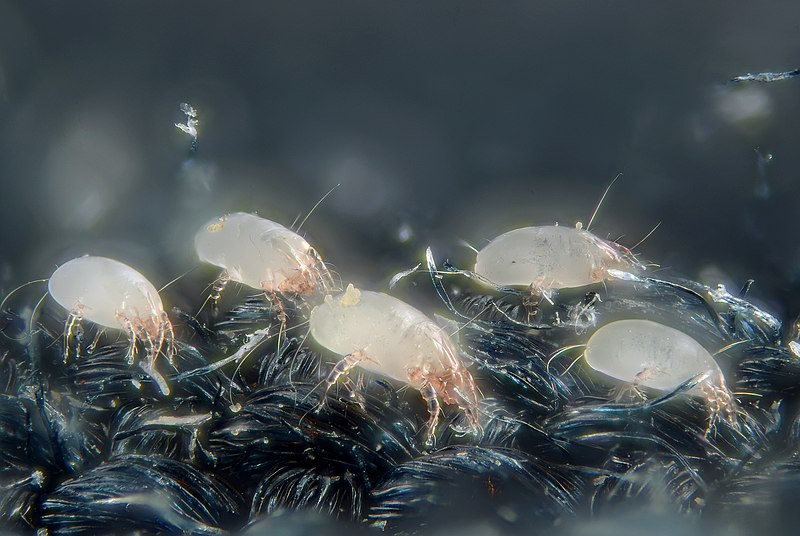Winter allergies can be incredibly tiring. They result in a variety of unpleasant symptoms, such as a runny nose, sore throat, or constant sneezing. The causes of winter allergy can be anything from outdoor pollens to indoor dust mites.
Of these, dust mites are the bigger culprit. Why? Because they are primarily found on our bedding, which is where we spend 40-50% of our time sleeping. Medication can obviously help, but it is always best to minimize your exposure to dust mites by allergy-proofing your bedroom and bedding.
In this post, we will look into the different ways to achieve that, with the main focus on the usage of hypoallergenic or allergy-proof bedding. But first, let us understand how dust mites result in winter allergies.
How do dust mites result in winter allergies?

Source
Dust mites are innocuous creatures that are part and parcel of human life. They are invisible to the naked eye and thrive in warm and humid conditions. You can find millions of dust mites, their feces, and decaying parts in your bedroom. They fill up your mattress, pillows, and comforters and particularly like your dry winter skin cells.
Whenever you move around in your bed, these allergens get disturbed and become airborne. They are then inhaled by you. If you are someone suffering from asthma or COPD, this can result in coughing and sneezing throughout the night. The following day, you will end up waking with puffy eyes, a runny nose, and chest congestion, all of which can take a toll on your physical and mental health.
Why is it better to prevent winter allergies than treat them?
Source
This is a common question that most people have. After all, why bother till you actually don’t get them? Also, it is similar to the common cold we all get, which can be easily treated by OTC medicines. This is a huge mistake that most people make.
For starters, winter allergies are different from common colds. Even though both share very similar symptoms, the common cold is a viral infection, while winter allergies are your body’s response to an irritant or trigger.
Colds usually do not last more than a couple of weeks, while allergies last till the allergens are actually present. This makes it important to solve the root cause of winter allergies rather than treat them.
Secondly, treating allergies using OTC medicines is more difficult than you think. Some of the drugs used have plenty of side effects, which can cause more harm than good. For instance, many medicines contain decongestants that can raise the patient's heart rate. Some others can cause body tissues to dry out and promote urinary retention.
Long story short, prevention is always better than cure when it comes to winter allergies.
Thankfully, there are certain steps that you can take to eliminate the root cause of winter allergies, aka dust mites, in your home. This way, you can eradicate the chances of anyone getting winter allergies at your home. Let us look at those steps now.
How to prevent winter allergies by transforming your bedding?
The following are some of the useful ways involving your bedding to make your bedroom winter-allergy-free:
1. Deep clean your sheets and pillow covers every week
Dust mites usually live in the folds and creases of your sheets and pillow covers. So the only way to protect yourself from these microscopic creatures is by deep cleaning them every week. It is recommended to wash it in water that is at least 130°F.
Post-washing, follow it up with a hot drying cycle to eliminate the dust mites, plus all the dirt, sweat, skin cells, and oil buildup. This should be your first line of defense against potential winter allergies.
When you use Bargoose protective sheets and pillow covers, you do not have to worry about the fabric getting ruined due to high temperatures while laundering.
Bargoose products are designed and commercially tested in such a way that they can withstand high temperatures during the laundering process.
2. Use allergy-free mattress covers

Source
Allergy-free or dust mite-proof bedding can drastically reduce your symptoms by preventing dust mites from reproducing. These beddings are usually made of materials like cotton, wool, microfiber, and bamboo, all of which have moisture-absorbing and antimicrobial properties.
This characteristic makes it naturally resistant to dust mites. These beddings also have a higher thread count as tightly-woven fabric structures eliminate gaps where dust mites can thrive.
Some allergists even suggest using silk as your bedding fabric. Silk not only fights off allergens but also soothes your skin. However, silk beddings are quite expensive and usually out of budget for most homes, hotels, and hospitals.
And this is where our AllergyCare™ Allergen Barrier Bedding Collection scores. Not only is it highly affordable, but it is also extremely effective in keeping allergens at bay. It prevents allergens from becoming airborne because it has been carefully woven to create a pore size smaller than 4.9 microns, enough to prevent allergens from passing through from the bed to your lungs.
Here are two more reasons to use hypoallergenic mattress encasement:
- It completely covers your mattress, thereby keeping the dust mites away from their food source (your dead skin cells). Without food, they will starve to death.
- It keeps the mattress clean. We all sweat, and our skin releases a lot of oil, all of which soak into the mattress. Putting a cover will ensure that your mattress doesn’t come in contact with sweat or oil, thus keeping it clean. Washing and replacing a cover is also a lot cheaper than replacing a mattress.
3. Apply allergy-proof zippered pillow protectors
Just to take the protection one notch higher, you can apply tightly woven covers on your pillows to keep dust mites out. Allergists recommend pillow covers as a great way to improve breathing while you sleep, as dust mite feces can enter your airway when the pillows are not covered properly. More importantly, it should be a zippered pillow protector so that it can be easily removed and washed at any time.
Take the case of our CleanAir® allergy relief pillow protector. It prevents allergens from coming in contact with your skin, nose, and lungs. Also, the stretch polyester material used to make these pillow protectors is an effective barrier against dust mites and other harmful allergens.
Tips to protect yourself from winter allergies
Apart from your bedding, here are some handy tips to make your bedroom allergy-free during winter:
1. Completely declutter your space
Here is a simple thumb rule when it comes to dust mites: if an item has the ability to trap dust, it will attract dust mites. It could be anything from home decor items, carpets, non-leather chairs, books, excess throw pillows, etc. So ensure that you move all of them to a different room in case you don’t need them, and keep the room minimalistic and clutter-free. If possible, ensure that your bedroom contains only the bed and nothing else.
2. Vacuum regularly
Vacuum every nook and corner of your bedroom every day. If you have carpet floors, consider replacing them with hard floors if possible. Remove all the rugs as they tend to collect dust and dust mites. More importantly, ensure that your vacuum cleaner has a double microfilter bag or HEPA filter. And while vacuuming, don’t forget to wear a mask so you don’t inhale the disturbed allergens. Always vacuum during the daytime so that the remaining dust can settle down before you hit the bed and you don’t inhale them.
3. Keep the environment dry and cool
As we have pointed out earlier, dust mites thrive and survive in moist and humid conditions. So ensure that you use an air conditioner when it is warm outside, even if you are tempted to open the windows to enjoy the outdoor breeze. Dust mites can’t breed in temperatures below 77 F.
If you live in humid conditions, install a dehumidifier to keep the humidity levels low. And avoid leaving damp or sweaty clothes on the floor, clothes basket, or the hanger. Bonus if you could install an air-filtration system in your room that uses HEPA filters to trap all the allergens.
The first step towards an allergy-free winter can be taken by choosing Bargoose’s protective bedding solutions. All our products, be it the mattress protectors, duvet covers, or pillow covers, are comfortable, highest-quality, and simplest allergen barrier sleeping solutions. By picking our bedding solutions, deeper sleep and allergy-free sleep is guaranteed.
Check out our full range here.








Leave a comment